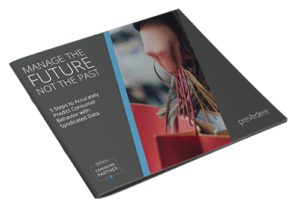Last Updated: January 12, 2021
The benefits of incorporating predictive analytics into business decision making are well documented – creating more effective marketing campaigns, optimizing supply chain and staffing decisions, and ultimately increasing revenue while decreasing costs.
However, companies often jump on the predictive analytic data bandwagon without fully evaluating their data strategies including, what data they plan to collect, how they will evaluate it and how they will act on the results.
To help companies approach analytics more effectively, here are the top mistakes we see retailers make when trying to incorporate analytics into their business processes.
Avoid mistakes using predictive analytics
- Trying to boil the ocean – The potential data sets a retailer can use are virtually endless. From customer behaviors and internal performance metrics to third-party industry statistics/trends from companies like Nielsen to open data available on economies worldwide – companies that try to gain meaningful insights from ALL of the data available are destined to fail. Instead, focus solely on the key metrics that matter most to your business.
- Ignoring leading indicators – Speaking of the metrics that matter to your business, those that tell you what happened in the past can certainly help you add context to previous performance. However, they do nothing to help you plan for the future. Instead, prioritize the data sets that help predict your future performance.
- Creating single use, point-in-time data models – Many current statistical modeling methods are out of date as soon as they are developed. Creating data models that paint a picture of a specific point in time can’t help you plan. Instead, create models that are automatically updated as leading indicators and key performance metrics change. Read a detailed conversation on leading indicators here.
 Not aligning with the company’s data analytics strategy – At this point, retailers know that they should be using data. However, incorporating data analytics into business processes requires more than just collecting and reviewing data. The time spent on these efforts is wasted if business units don’t understand the methodology or do feel that insights from the data team are not timely enough.
Not aligning with the company’s data analytics strategy – At this point, retailers know that they should be using data. However, incorporating data analytics into business processes requires more than just collecting and reviewing data. The time spent on these efforts is wasted if business units don’t understand the methodology or do feel that insights from the data team are not timely enough.- Ignoring what the data says – Because nearly half of executives are not aligned with their own data strategy, too often, executives rely on gut feel. Research is showing that this statistically leads to decisions with poor outcomes. With consumer preferences changing rapidly in response to e-commerce, wearables, and potentially soon, VR, there is no better time to incorporate analytics to prepare for these changing dynamics.
- Limiting data use to a single decision/business unit – Predictive analytics has benefits throughout an organization, but often its adoption is siloed, and these benefits aren’t shared. Likewise, data may be used to focus on one key performance metric – like overall sales, but SKU-level or market-level variations are ignored.
- Focusing on single channel data sets – Similarly, we often see silos in the data sets used. In-store metrics aren’t married to e-commerce. Mobile shopping habits are siloed off for a mobile team to analyze. Instead, these metrics should be integrated for a true understanding of trends.
- Treating all data as equal – Not all data is quality data. It’s important for retailers to thoroughly examine the credibility of their data sources and cleanliness of their data sets or risk making decisions on outdated or erroneous metrics. You can read more about the 5-critical steps to incorporate the latest in predictive analytics and syndicated data to predict consumer purchase behavior.
- Focusing on the individual alone – Data on individual preferences can be hugely helpful in sales and marketing processes, allowing retailers to hone in on exactly what a customer is most likely to buy, and when. But if retailers don’t bubble up these metrics to see bigger trends, they are missing the opportunity to make smarter, data-informed decisions.
- Not communicating the results – Retailers can’t act on data analytics if they don’t know what the data says. Communicating findings to all of the teams that need the data to make better decisions are the only way that retailers can actually create meaningful changes based on the results.
What other mistakes have you seen retailers make? Who do you think is doing it right? Tell us in the comments below, and check out some of our case studies of retailers using data and predictive analytics here.
This free illustrated playbook describes the 5 critical steps to incorporate the latest in predictive analytics and syndicated data to predict consumer purchase behavior with remarkable accuracy. Click to download here.

